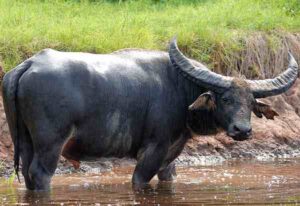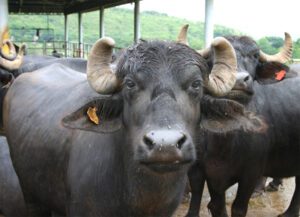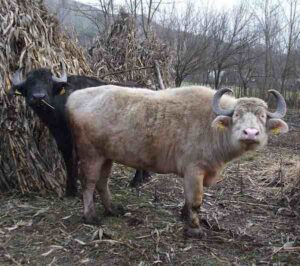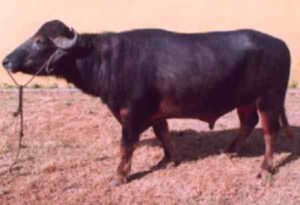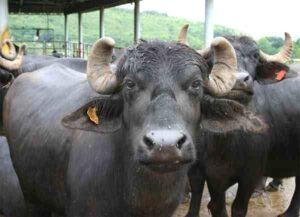The Nili Ravi buffalo is a breed of domestic buffalo which is similar to the Murrah buffalo. It is distributed in Bangladesh, China, India, Pakistan, Philippines and Sri Lanka.
But it is principally distributed in India and Pakistan, and is concentrated in the Punjab. It is mainly a dairy buffalo breed and used mainly for milk production.
The Nili Ravi buffalo breed date back to the Indus River Valley civilizations when they were two different buffalo, Nili and Ravi.
However, due to coincidental standards, both buffalo breeds looked very similar and it became hard to distinguish the two. So, the two breeds became one, Nili Ravi in 1950.
Origin and History of Nili Ravi Buffalo
The Nili Ravi buffalo has its roots in India Pakistan, and the breed is known and popular for its strong and productive characteristics. It originated in the Punjab region, which spans both India and Pakistan.
The history of these buffaloes dates back to the early 20th century. The name “Nili-Ravi” comes from the two rivers, the Nilab and Ravi. And these rivers are situated in the region where the breed was developed.
Over time, the Nili Ravi has turned into a valuable dairy breed, through selective breeding and careful management practices. Now the breed is highly prized for its adaptability and the high-quality milk production. And today, the Nili Ravi is a significant breed in the dairy industry of South Asia.
Nili Ravi Buffalo Characteristics
The Nili Ravi buffalo breed has a wedge shaped body with massive frame. These animals are mostly black in color, but often have white markings on the forehead, face, muzzle and lower parts of the legs (due to which it is also called ‘Panj Kalyan‘).
Their horns are small and curly and have wall eyes. The females have a larger and strong udder. Average body height of the mature males is around 135 cm for males, and around 125 cm for females. Average live body weight of the mature Nili Ravi is around 700 kg for males and around 600 kg for females.

Housing Requirements
Housing requirements of these animals is very easy and simple. Although, providing them with a suitable housing system is very important to ensure their good health and productivity.
Try to make a comfortable and clean housing system for your animals that protects them from harsh weather conditions (like excessive heat, cold, and rain). And also ensure a good ventilation system.
Ensure enough housing space for each buffalo, and try to keep separate place for kids and nursing female buffaloes. Install adequate lighting system and make good drainage system. Try to clean the house on a regular basis, and doing this is necessary to keep the buffaloes healthy.
Dietary Requirements
Feeding the animals with very good quality and nutritious food is the most important part of keeping these buffaloes. And meeting their dietary needs is very important for their good health and milk production.
Like many other breeds, the Nili Ravi buffaloes also require a balanced diet that includes a mix of good-quality forages, grains, and supplements. Providing them with high-quality green fodder (like grass and legumes) is also essential for their good health.
Providing them grains (such as wheat and maize) along with protein-rich supplements, helps to meet their nutritional requirements. Always try to provide your animals with enough fresh and clean water.
Breeding/Reproduction
Breeding Nili Ravi buffaloes is very easy and simple. They are naturally very good breeders. The female buffaloes generally reach maturity at around 2 years of age. You can practice both AI and natural mating for breeding your buffaloes.
After successful breeding, the gestation period is about 9 months. The calf and the mother require special care after giving birth, the calf needs special care
Temperament
The Nili Ravi buffaloes are known for their calm and gentle temperament. They are generally easy to handle, not easily agitated, and are friendly towards humans. However, like many other animal, individual temperaments can vary. And it is essential to treat each buffalo with care and respect.
Health
Ensuring the good health of Nili Ravi buffaloes is very important for their good productivity. Perform regular health check-ups by a veterinarian and try to address any potential issues early on.
Vaccinate them timely against common diseases to prevent illnesses. Practice good hygiene (such as regular cleaning of the barn and proper waste management), and doing this is very important because it contribute to a healthy environment.
Caring
Taking good care of these animals is very important for their good health and high milk production. And their caring tasks involve providing them a comfortable and clean living space with proper ventilation, providing a well-balanced nutritious diet that includes good-quality forage, grains, and supplements, regular health check-ups and regular vaccinations.
Also try to maintain a stress-free environment, handle them gently, and ensure that they have access to fresh and clean water.
Popularity and Price
The Nili Ravi buffalo is popular breed in it’s native area South Asia (especially in India and Pakistan). It is popular mainly for its high milk production and adaptability to local climates. Most of the dairy farmers value them for their docile nature and suitability for dairy farming.
And the high popularity of Nili Ravi buffaloes has led to a relatively higher price as compared to other buffalo breeds. It’s tough to tell the exact price, because it depends on numerous factors such as age, health condition, and productivity. Visit your local livestock market or farms to know more about current pricing.
Lifespan
Average lifespan of the Nili Ravi buffaloes is around or up to 15 to 20 years. Although exact lifespan can vary and depends on numerous factors such as proper nutrition, healthcare, and a comfortable living environment.
Uses
Nili Ravi is a dairy buffalo breed and it is mainly used for milk production. They they are known for providing a significant amount of high-quality milk. And the milk is used to make various dairy products like butter, ghee, and yogurt.
Milk Production
Nili Ravi buffaloes are known for their excellent milk production, and they are very good for dairy farming. They produce 15 to 18 kg milk daily, and the average milk yield is approximately 2000 kg per year. The record yield is 6535 kg in a lactation of 378 days.

Pros and Cons of Nili Ravi Buffaloes
Like many other buffalo breeds, the Nili Ravi also has some pros and cons. Here we are going to list the top pros and cons.
Pros:
- High milk production
- Adaptability to local climate and environmental conditions
- Strength for farm work
- Versatility
- Docile temperament
Cons:
- Higher initial cost
- Space and feeding requirements
- Some health issues
Special Notes
The Nili Ravi buffaloes are generally docile in terms of temperament. The males on average mature within their 30 months of age, and the females within their 36 months of age. Average first calving age is around 45 months. The females are very good for milk production.
Average approximate milk production is around 2000 kg per year (maximum recorded yield is 6535 kg in a lactation period of 378 days). And longevity of milk production is good.
Milk of these animals is of very good quality, containing more than 6 percent of fat. However, review full breed profile of the Nili Ravi buffalo in the table below.
| Breed Name | Nili Ravi |
| Other Name | None |
| Breed Purpose | Milk |
| Special Notes | Large animals, massive body, docile temperament, the males generally mature within 30 months and the females within 36 months, average first calving age is around 45 months, the breed is very good for milk production, they produce around 2000 kg of milk per year, the longevity of production is good, milk is of very good quality containing over 6 percent fat |
| Breed Size | Large |
| Bulls | Around 700 kg |
| Cows | Around 600 kg |
| Climate Tolerance | Native climates |
| Color | Black or brown |
| Rarity | Common |
| Country/Place of Origin | India/Pakistan |
Frequently Asked Questions (FAQs)
People often ask questions related to these buffaloes. Here we are trying to list the most common and frequently asked questions about Nili Ravi buffalo and trying to answer them.
How to recognize Nili Ravi buffalo?
You can easily recognize the Nili Ravi buffalo by its distinct physical characteristics. These buffaloes have a relatively large, heavy-set body with a broad forehead and wide nostrils. Their skin color is usually black with some white markings over body, particularly on the face and legs. They have long, and curved horns that can extend backward in a semi-circular shape.
Why Nili Ravi buffalo is called Punjkaliana?
Yes, Nili Ravi is often called “Punjkaliana” in some regions, particularly in Punjab, India. The term “Punjkaliana” reflects its association with the Punjab region. And it also emphasizes its significance in local agriculture and dairy production.
How much milk does a Nili Ravi buffalo produce a day?
Depends on numerous factors. A healthy Nili Ravi cow typically produce between 10 to 20 liters of milk per day. Although, exact milk production can vary based on management techniques, diet or nutrition, and genetics also.
What is the origin place of Nili Ravi buffalo?
The origin place of the Nili Ravi buffalo is the belt between the Sutluj and Ravi rivers of Punjab.


